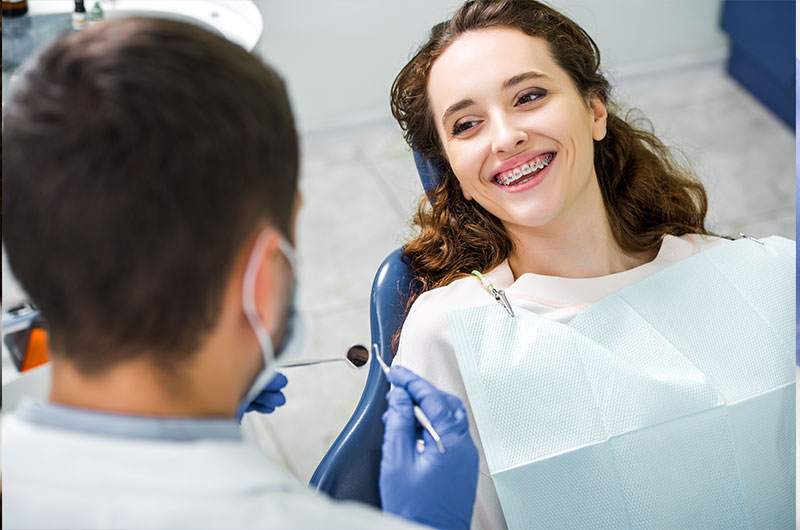How To Find the Best Orthodontist For Your Needs
West Coast Dental has the orthodontic expertise, tools and training to give you the smile of your dreams. Whether you are young or young at heart, we will recommend the best orthodontist for your needs and help you construct an effective treatment plan (including affordable braces) to treat your specific issues.
Let’s explore who needs braces, the types of braces available and how West Coast Dental helps you make the most of your orthodontic experience.
How to Know If You Need Braces
If your teeth are crowded, crooked or misaligned, braces can change your life. Straight teeth not only look better, but they’re also healthier and easier to keep clean. Plus, an improved bite helps you avoid jaw pain.
When it comes to orthodontic care, the earlier the better. Early consultation and treatment may make it possible to avoid or shorten the time needed for straightening your teeth. We recommend that children see a pediatric orthodontist no later than age 7.
Teeth Crowding
Teeth crowding occurs when there isn’t enough space in your mouth to allow your teeth to grow in straight. This causes the teeth to shift which impacts alignment. Teeth crowding may be caused by an imbalanced tooth-to-jaw ratio, or it can be caused by baby teeth that come out too early.
Crooked Teeth
Crooked teeth are simply teeth that did not grow in straight. They may be caused by a variety of factors including jaw size and alignment, genetics, thumb sucking and poor dental care. Some crooked teeth can cause alignment issues that impact your health and speech.
Jaw Alignment
Jaw alignment describes how your top and bottom teeth come together when you close your mouth. Ideally, your upper teeth should fit slightly over your bottom teeth. Common jaw alignment issues include overbites and underbites.
Types of Braces
Dental braces apply mild, constant pressure to gradually move your teeth. Your orthodontist will make regular adjustments to your braces until your teeth are perfectly aligned. There are several types of braces which are available in a variety of colors and materials to suit your needs.
Invisible Aligners
Clear aligners are becoming a very popular choice for teens and adults since they are nearly invisible and cause little disruption to daily life. As a braces alternative, these custom-made trays are molded to the shape of your teeth. When you need to eat or brush your teeth, you simply remove the trays for a short period of time.
Invisible braces gently apply pressure to gradually move your teeth. Your orthodontist will replace your trays about every two weeks to continue the alignment process.
Traditional Braces
Traditional metal braces are a time-tested, effective way to correct your smile. If you choose traditional braces, your orthodontist will attach metal brackets to the front of each tooth. A metal wire runs between each bracket. Colorful rubber bands attach to the front of each bracket to hold the wire in place.
Clear Braces
Clear braces are available to provide a more natural option for teeth straightening. They are made of a clear ceramic material that blends in with your natural smile which can give you added self-confidence during treatment. A metal wire runs between each ceramic bracket. The durable design of clear braces maintains its appearance over time without staining or discoloration.
What to Expect When You Get Braces at West Coast Dental
At West Coast Dental, your first orthodontic appointment will include a comprehensive exam, digital X-rays and a treatment consultation with an expert orthodontist. Based on this initial assessment, we will identify the braces or aligners that will work best for you.
Frequent Dental Visits
Once you start your orthodontic program, you’ll have an automatic appointment scheduled at West Coast Dental every few weeks. During these routine visits, your orthodontist will check your progress and adjust your braces, as needed.
Certified Orthodontists
Straightening teeth requires specialized expertise that goes beyond general dentistry. Our certified orthodontists are experts at moving teeth gently and safely for children, teens and adults. We understand the complex relationship between teeth and facial structures.
Unique Treatment for a Better Smile
At West Coast Dental, our orthodontists treat each patient as an individual with unique needs and goals. We work with you to properly assess your smile and develop a customized plan to deliver the results you want. To find the best orthodontist near you, book an orthodontist appointment today.
We offer a variety of payment options to make your crown affordable. We also accept most dental insurance plans and have a dental discount program for patients without insurance. Call us at our toll-free number 888-329-8111 or make an appointment online here.


